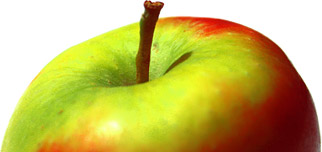Prairie Spy is one of the earliest apple varieties developed by the University of Minnesota. It was selected in 1923 from seeds planted in 1914, and introduced commercially in 1940. It was known as Minnesota 1007 during its development period.
The parentage of Prairie Spy is not certain, but the name, and its growth characteristics and fruit appearance suggest it is probably a seedling of Northern Spy - but this is not certain.
Although grown commercially for a period in Minnesota, Prairie Spy (like Northern Spy) is not best-suited to the needs of commercial growers. For example, it can take several years to start bearing, and fruit size can be highly variable.
Most tasting tests rate Prairie Spy as having an excellent well-balanced sweet flavor.
USDA identification images for Prairie Spy
The identification paintings in the USDA Pomological Watercolor Collection span the years 1886 to 1942.
Citation: U.S. Department of Agriculture Pomological Watercolor Collection. Rare and Special Collections, National Agricultural Library, Beltsville, MD 20705.
Parents and other ancestors of this variety
- Northwestern Greening (parent)
- Wealthy (parent)
Visitor reviews
- 12 Oct 2024We had two trees up at the cabin north of Mora Mn. They were excellent tasting apples firm and crunchy. We liked them so much that when we moved we planted 2 trees on our new property south of St. Cloud Mn. unfortunately that was almost 4 years ago and they still have not grown very much and have produced nothing, not sure what we are doing wrong.
- 07 Sep 2022This tree is great for pies and apple butter. Is Disease, and Japanese beetle resistant. Large late season fruit, that produces to point you think limbs will break!
- 29 Sep 2019 ILLINOIS, United Statesthe Prairie Spy is a delicious and crisp apple that reminded me of a Honeycrisp. I have 1 tree and next year I shall have more.
- 29 Apr 2017 MINNESOTA, United StatesI have had the pleasure of enjoying these apples for 34 years. My mother in law planted it before my husband and I move on the farm. It is over 40 years old!Great for eating off the tree and best for baking.
- 20 Nov 2016 United StatesExcellent Apple!
- 14 Oct 2015 MN, United StatesI loved it at first taste.
Tree register
United States
- Arthur Pitt in Finlayson, MN/PINE
- Becky Liegl in Waupaca, WI/WAUPACA
- Brian Van Erem in Green Bay, WI
- Erin Eyberg in Minneapolis, MINNESOTA
- Florian Deisenhofer in Brush Prairie, CLARK COUNTY WA
- Gil Schieber in Snohomish, WASHINGTON
- Karl Schmidt in Estelline, SD
- Kellogg Hill Farms in SOUTH DAYTON, NY
- Kent Montgomery in Brainerd, MINNESOTA / CROW WING
- Margie Elwood in ELKO, NEVADA
- Nick in SCANDIA, MINNESOTA
- Rob in EAST RYEGATE, VT
- Ron Fischer in Orion, IL.
- Steve in Silver Spring, MD
- Steven Holman in Skandia, MI
- Thomas Griffith in Cottage Grove, WI
- V. Talsma in Bruce Crossing, MI
Spring blossom records for this variety
2022 season
- 30th April 2022 - tree owned by Gil in Snohomish, United States
- 30th April 2022 - tree owned by Gil in Snohomish, United States
2019 season
- 11th June 2019 - tree owned by Steven in Skandia, United States
2018 season
- April 2018 - tree owned by Margie in ELKO, United States
2012 season
- 6th May 2012 - tree owned by Florian in Brush Prairie, United States
Record your blossom dates in our Fruit Tree Register - more >>.
Harvest records for this variety
2022 season
- 2nd week September 2022 - tree owned by Gil in Snohomish, United States
- 2nd week September 2022 - tree owned by Gil in Snohomish, United States
2018 season
- 2nd week October 2018 - tree owned by Margie in ELKO, United States
2013 season
- 3rd week August 2013 - tree owned by V. in Bruce Crossing, United States
2011 season
- 1st week October 2011 - tree owned by Erin in Minneapolis, United States
Origins
- Species: Malus domestica - Apple
- Parentage: Wealthy x Northwest Greening
- Originates from: Excelsior, MN, United States
- Introduced: 1940
- Developed by: University of Minnesota
- UK National Fruit Collection accession: 1951-062
Identification
- Country of origin: United States
- Period of origin: 1950 - 1999
- Developer: University of Minnesota
Using
- Picking season: Late
- Keeping (of fruit): 3 months or more
- Flavour quality: Very good
- Flavour style (apples): Sweeter
- Cropping: Good
- Food uses: Eating fresh
- Food uses: Culinary
Growing
- Flowering group: 3
- Vigour: Average vigour
- Precocity: Slow to start bearing
- Fruit bearing: Spur-bearer
- Self-fertility: Not self-fertile
Climate
- Cold hardiness (USDA): Zone 3 (-40C)
Other qualities
- Disease resistance: Good
Where to buy fresh fruit
The following orchards grow Prairie Spy:
United States
Iowa
- Apples on the Avenue, Nashua
- Berry Patch Farm, Nevada
- Wilson's Orchard, Iowa City
Minnesota
- Aamodt's Apple Farm and Bakery, Stillwater
- Fireside Orchard and Gardens, Northfield
- Maple Run Orchard, Finlayson
- Minnesota Harvest, Jordan
- Nelson's Apple Farm, Webster
- Sekapp Orchard, Rochester
- Sogn Valley Orchard, Dennison
- Southwind Orchards, Dakota
- Sweetland Orchard, Webster
New Hampshire
- Old Ciderpress Farm, Westmoreland
Pennsylvania
- Northrop's Apple Acres, Lake City
South Dakota
- Krause Family Orchard & Nursery Inc., Glenham
Wisconsin
- Door Creek Orchard, Cottage Grove
- Lucy's Farm, Waupaca

